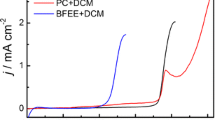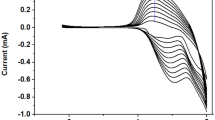Abstract
EDOTDTR with a dithiarubicene (DTR) core and 3,4-ethylenedioxythiophene (EDOT) flanking group was synthesized by a Migita-Kosugi-Stille cross-coupling reaction. The EDOTDTR exhibited long-wavelength absorption at 822 nm and a narrow electrical bandgap energy (Egelect = 1.32 eV) due to its efficient intramolecular charge transfer. Chemical polymerization by FeCl3 in CHCl3 solution and electropolymerization on an ITO electrode yielded the conjugated polymers polyDTRchem and polyEDOTDTRelect, respectively. CV measurements revealed that the redox processes of the polymer films were reversible and not diffusion-limited. Both conjugated polymers exhibited an absorption band at 480 nm, indicating that their π-π* transitions were not much influenced by polymerization. The absorption edge of the polyEDOTDTRelect film extended into the near-infrared region (λonset > 1000 nm), implying effective intra- and intermolecular charge transfer interactions between the DTR and EDOT segments. The polyDTRchem and polyEDOTDTRelect were electrochromic active, and the corresponding color changes were brought about by applying both positive and negative potentials. In particular, both polymer films showed good switching stabilities at the oxidation potential, as confirmed by spectroelectrochemistry.






Similar content being viewed by others
References
Grimsdale AC, Chan KL, Martin RE, Jokisz PG, Holmes AB. Synthesis of light-emitting conjugated polymers for applications in electroluminescent devices. Chem Rev. 2009;109:897–1091.
Günes S, Neugebauer H, Sariciftci NS. Conjugated polymer-based organic solar cells. Chem Rev. 2007;107:1324–38.
Yang J, Zhao Z, Wang S, Guo Y, Liu Y. Insight into high-performance conjugated polymers for organic field-effect transistors. Chem. 2018;4:2748–85.
McQuade DT, Pullen AE, Swager TM. Conjugated polymer-based chemical sensors. Chem Rev. 2000;100:2537–74.
Mullekom HAM, Vekemans JAJM, Havinga EE, Meijer EW. Developments in the chemistry and bandgap engineering of donor-acceptor substituted conjugated polymers. Mater Sci Eng R: Rep. 2001;32:1–40.
Lv X, Li W, Ouyang M, Zhang Y, Wright DS, Zhang C. Polymeric electrochromic materials with donor–acceptor structures. J Mater Chem C. 2017;5:12–28.
Beaujuge PM, Reynolds JR. Color control in π-conjugated organic polymers for use in electrochromic devices. Chem Rev. 2010;110:268–320.
Beaujuge PM, Ellinger S, Reynolds JR. The donor-acceptor approach allows a black-to-transmissive switching polymeric electrochrome. Nat Mater. 2008;7:795–9.
Wang K, Zhu L, Hu X, Han M, Lin J, Guo Z, et al. Novel core-substituted naphthalene diimide-based conjugated polymers for electrochromic applications. J Mater Chem C. 2021;9:16959–65.
Figà V, Chiappara C, Ferrante F, Casaletto MP, Principato F, Cataldo S, et al. Symmetric naphthalenediimidequaterthiophenes for electropolymerized electrochromic thin films. J Mater Chem C. 2015;3:5985–94.
Singhal S, Patra A. Benzothiadiazole bridged EDOT based donor-acceptor polymers with tunable optical, electrochemical, morphological and electrochromic performance: effects of solvents and electrolytes. Phys Chem Chem Phys. 2020;22:14527–36.
Beaujuge PM, Vasilyeva SV, Ellinger S, McCarley TD, Reynolds JR. Unsaturated linkages in dioxythiophene-benzothiadiazole donor-acceptor electrochromic polymers: the key role of conformational freedom. Macromolecules. 2009;42:3694–706.
Durmus A, Gunbas GE, Camurlu P, Toppare L. A neutral state green polymer with a superior transmissive light blue oxidized state. Chem Commun. 2007:3246–8.
Beaujuge PM, Ellinger S, Reynolds JR. Spray processable green to highly transmissive electrochromics via chemically polymerizable donor–acceptor heterocyclic pentamers. Adv Mater. 2008;20:2772–6.
Kerszulis JA, Bulloch RH, Teran NB, Wolfe RMW, Reynolds JR. Relax: a sterically relaxed donor−acceptor approach for color tuning in broadly absorbing, high contrast electrochromic polymers. Macromolecules. 2016;49:6350–9.
Balan A, Gunbas G, Durmus A, Toppare L. Donor-acceptor polymer with benzotriazole moiety: enhancing the electrochromic properties of the “Donor Unit”. Chem Mater. 2008;20:7510–3.
Içli M, Pamuk M, Algi F, Önal AM, Cihaner A. Donor-acceptor polymer electrochromes with tunable colors and performance. Chem Mater. 2010;22:4034–44.
Durmus A, Gunbas GE, Toppare L. New, highly stable electrochromic polymers from 3,4-ethylenedioxythiophene-bis-substituted quinoxalines toward green polymeric materials. Chem Mater. 2007;19:6247–51.
Gunbas GE, Durmus A, Toppare L. A unique processable green polymer with a transmissive oxidized state for realization of potential RGB-based electrochromic device applications. Adv Funct Mater. 2008;18:2026–30.
Zhang Y, Chen S, Zhang Y, Du H, Zhao J. Design and characterization of new D–A type electrochromic conjugated copolymers based on Indolo[3,2-b]Carbazole, isoindigo and thiophene units. Polymers. 2019;11:1626.
Chen X, Qiao W, Wang ZY. Visible and near-infrared electrochromic thiophene-diketopyrrolopyrrole polymers. RSC Adv. 2017;7:15521–6.
Li W, Michinobu T. Electrochromic behavior of donor-acceptor polymers containing diketopyrrolopyrrole unit. J Photopolym Sci Tech. 2017;30:495–9.
Sonmez G, Shen CKF, Rubin Y, Wudl F. A red, green, and blue (RGB) polymeric electrochromic device (PECD): the dawning of the PECD era. Angew Chem Int Ed. 2004;43:1498–502.
Sonmez G, Sonmez HB, Shen CKF, Jost RW, Rubin Y, Wudl F. A processable green polymeric electrochromic. Macromolecules. 2005;38:669–75.
Mohebbi AR, Wudl F. Electron-accepting dithiarubicene (emeraldicene) and derivatives prepared by unprecedented nucleophilic hydrogen substitution by alkyllithium reagents. Chem Eur J. 2011;17:2642–6.
Tsukamoto K, Takagi K, Nagano S, Hara M, Ie Y, Osakada K, et al. π-Extension of electron-accepting dithiarubicene with a cyano-substituted electron-withdrawing group and application in air-stable n-channel organic field effect transistors. J Mater Chem C. 2019;7:12610–8.
Tsukamoto K, Takagi K, Yamamoto K, Ie Y, Fukushima T. End-functionalization of dithiarubicene: modulation of optoelectronic properties by metal-catalyzed coupling reactions and device application. J Mater Chem C. 2021;9:9520–9.
Mohebbi AR, Yuen J, Fan J, Munoz C, Wang MF, Shirazi RS, et al. Emeraldicene as an acceptor moiety: balanced-mobility, ambipolar, organic thin-film transistors. Adv Mater. 2011;23:4644–8.
Gaussian 09, Revision E.01. Wallingford, CT: Gaussian, Inc.; 2013 (see Supporting Information for the detail).
Zhou F, Liu R, Li P, Zhang H. On the properties of S···O and S···π noncovalent interactions: the analysis of geometry, interaction energy and electron density. N J Chem. 2015;39:1611–8.
Yu ZD, Lu Y, Wang JY, Pei J. Conformation control of conjugated polymers. Chem Eur J. 2020;26:16194–205.
Leriche P, Blanchard P, Frère P, Levillain E, Mabon G, Roncali J. 3,4-Vinylenedioxythiophene (VDOT): a new building block for thiophene-based π-conjugated systems. Chem Commun. 2006:275–7.
Sonmez G, Meng H, Wudl F. Very stable low band gap polymer for charge storage purposes and near-infrared applications. Chem Mater. 2003;15:4923–9.
Acknowledgements
A part of this work was financially supported by and performed under the Cooperative Research Program of “Network Joint Research Center for Materials and Devices: Dynamic Alliance for Open Innovation Bridging Human, Environment and Materials”. The computations were performed using Research Center for Computational Science, Okazaki, Japan. KT thanks the Research Program for Next Generation Young Scientists for their support. TY is grateful to the Sakamoto Donation Foundation for financial support and to Mr. Hayashi for his kind help in setting up the experiment.
Author information
Authors and Affiliations
Corresponding author
Ethics declarations
Conflict of interest
The authors declare no competing interests.
Additional information
Publisher’s note Springer Nature remains neutral with regard to jurisdictional claims in published maps and institutional affiliations.
Supplementary information
Rights and permissions
About this article
Cite this article
Takagi, K., Yamamori, T. & Tsukamoto, K. Oxidative (co)polymerization of dithiarubicene derivatives and electrochromic properties of narrow-bandgap conjugated polymers. Polym J 54, 1055–1062 (2022). https://doi.org/10.1038/s41428-022-00655-7
Received:
Revised:
Accepted:
Published:
Issue Date:
DOI: https://doi.org/10.1038/s41428-022-00655-7
- Springer Nature Limited




